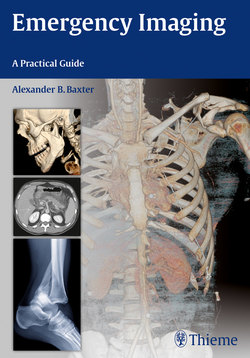Читать книгу Emergency Imaging - Alexander B. Baxter - Страница 55
На сайте Литреса книга снята с продажи.
Оглавление41
2Brain
and dilated. Further compression forces the contralateral cerebral peduncle against the tentorial dural reflection and injures descending motor fibers, causing ipsilat-eral hemiparesis. The posterior cerebral artery can also be compressed in uncal herniation, causing an ipsilateral temporal/occipital infarct with visual field defects opposite the injured hemisphere.
Downward (central) herniation occurs in severe bilateral hemispheric injuries. Inferior brainstem displacement com-promises its vascular supply and can lead to ischemic or reperfusion injury. Cross- sectional imaging findings include cister-nal eacement, compression of the cere-bral peduncles, and ventral or ventrolateral brainstem hemorrhage (Duret hemor-rhage) located near the midline at the pon-tomesencephalic junction.
Upward transtentorial herniation can occur with cerebellar hemorrhage, low oc-cipital trauma, or infratentorial masses. Like downward transtentorial herniation, it can result in brainstem ischemia and hemorrhage.
Signs and symptoms of herniation often develop rapidly and include somnolence or stupor, agitation, neurologic deficits, cranial nerve palsies, and “Cushing triad” (hypertension, bradycardia, and irregular respiration) (Fig. 2.15).
◆Cerebral Herniation
Cerebral herniation is defined by displace-ment of swollen or compressed brain acrossthe falcine and tentorial dural reflections, through a calvarial defect, or through theforamen magnum. Causes include subduralor epidural hematomas, parenchymal hem-orrhage, tumors, and focal cerebritis or ab-scess. Depending on location, direction, andseverity, herniated brain can compress cra-nial nerves and descending and ascendingbrainstem fiber tracts, obstruct intraventric-ular CSF flow, and occlude cerebral arteries.
The most common pattern is subfalcine herniation, in which the cingulate gyrus herniates under the falx. Contralateral hy-drocephalus (ventricular trapping) results from obstruction of the lateral ventricle at the foramen of Monro. Compression of the anterior cerebral artery branches, when displaced across the falx, can cause an ip-silateral superior frontal or cingulate gyrus infarct, which may manifest clinically as contralateral leg weakness.
Brain herniation through the tentorial notch can be either downward (central), upward (due to posterior fossa hemor-rhage), or lateral (uncal). Uncal herniation is more common than other transtentorial herniations. As the herniating medial tem-poral lobe compresses parasympathetic fi-bers on the periphery of the third cranial nerve, the ipsilateral pupil becomes fixed
Fig. 2.15
a,b Acute subdural hematoma with subfalcine and uncal herniation. Hyperdense, crescentic left ho-lohemispheric SDH with hemorrhagic temporal contusion. Uncal herniation with complete cisternal ef-facement, displacement of the left lateral ventricular temporal horn to the midline, and trapping of the left lateral ventricle. Left posterior cerebral artery and anterior cerebral artery occlusion with traumatic cerebral infarcts involving the left occipital lobe (PCA distribution) and left superior frontal gyrus (ACA distribution).
c,d Downward transtentorial herniation with Duret hemorrhage. Diuse cerebral swelling with cisternal eacement, poor gray-white dierentiation, and large central pontine hemorrhage.
e,f Upward transtentorial herniation due to traumatic cerebellar hemorrhage. Diuse cerebellar swelling with upward transtentorial herniation, complete cisternal eacement, multiple pontine hemorrhages, and low-attenuation brainstem change.
